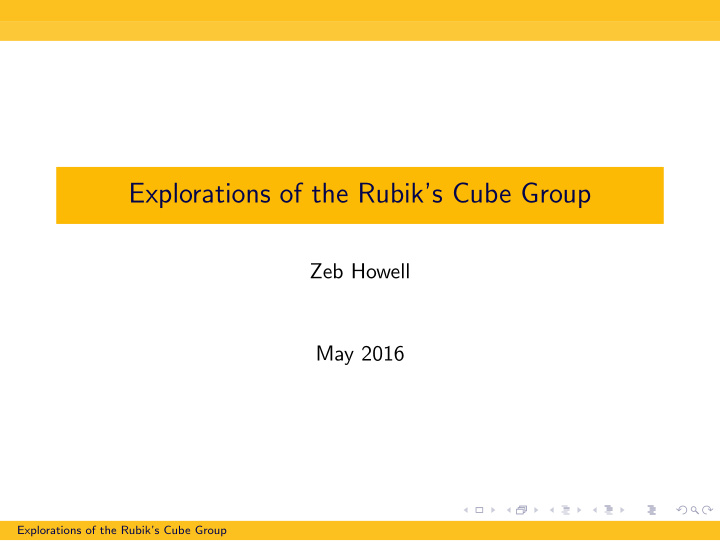



Explorations of the Rubik’s Cube Group Zeb Howell May 2016 Explorations of the Rubik’s Cube Group
What’s the Deal with Rubik’s Cubes? ◮ One Cube made up of twenty six subcubes called “cubelets”. ◮ Each cubelet has one, two, or three “facelets”. ◮ Three kinds of cubelet, defined by their number of facelets: 1. Six cubelets with one facelet: Center cubelets 2. Twelve cubelets with two facelets: Edge cubelets 3. Eight cubelets with three facelets: Corner cubelets ◮ 12! × 8! × 3 8 × 2 12 combinations. ◮ Not all these combinations can be reached! ◮ (Call this the Illegal Cube Group) Explorations of the Rubik’s Cube Group
The Cube Group Let the Cube Group G be the subgroup of S 48 generated by: R = (3,38,43,19)(5,36,45,21)(8,33,48,24)(25,27,32,30)(26,29,31,28) L = (1,17,41,40)(4,20,44,37)(6,22,46,35)(9,11,16,14)(10,13,15,12) D = (14,22,30,38)(15,23,31,39)(16,24,32,40)(41,43,48,46)(42,45,47,44) F = (6,25,43,16)(7,28,42,13)(8,30,41,11)(17,19,24,22)(18,21,23,20) U = (1,3,8,6)(2,5,7,4)(9,33,25,17)(10,34,26,18)(11,35,27,19) B = (1,14,48,27)(2,12,47,29)(3,9,46,32)(33,35,40,38)(34,37,39,36) Only even permutations! Explorations of the Rubik’s Cube Group
Edges and Corners Consider the set of cubelets C , and let the Cube Group act on C . ◮ Two orbits, C corners and C edges . ◮ Let P be the group induced by the action of G on C . Then: 1. P is the combination of all edge permutations and corner permutations. 2. P is a subset of ( S 8 × S 12 ) ∩ A 20 3. P contains A 8 × A 12 4. P has order 1 2 × 8! × 12! Explorations of the Rubik’s Cube Group
Orientations and Positions ◮ Each corner cubelet can be rotated by 2 π k radians, for any 3 integer k . ◮ Equivalent to Z 3 ! ◮ 8 corners means a direct product of Z 3 with itself 8 times. ◮ Similarly, rotate each edge cubelet by n π for any integer n to get Z 2 ◮ 12 edges means a direct product of Z 2 with itself 12 times. Explorations of the Rubik’s Cube Group
Time To Talk about Semi-Direct Products Definition Suppose that H 1 and H 2 are both subgroups of a group G . We say that G is the semi-direct product of H 1 by H 2 , written as H 1 ⋊ H 2 if ◮ G = H 1 × H 2 ◮ H 1 and H 2 only have the identity of G in common ◮ H 1 is normal in G Explorations of the Rubik’s Cube Group
Time To Talk About Wreath Products Definition Let X be a finite set where | X | = m , G be a group, and H a permutation group acting on X . Let G m be the direct product of G with itself m times, and let H act on G m by permuting the copies of G . Then the Wreath Product of G and H , written G ≀ H , is defined as G m ⋊ H . Explorations of the Rubik’s Cube Group
Back to the Cube Group ◮ C corners acts on the set of the corner cubelets as S 8 . ◮ The orientations of all of the corner cubelets can be described as a direct product of Z 3 with itself eight times. ◮ | S 8 | = 8 ◮ C corners is the direct product of the corner orientations and the corner positions. ◮ Z 8 3 is normal in C corners ◮ Thus, C corners ∼ = ( S 8 ≀ Z 3 ) Explorations of the Rubik’s Cube Group
Back to the Cube Group (continued) ◮ Similarly, C edges ∼ = ( S 12 ≀ Z 2 ) ◮ We know that C edges and C corners are separate orbits of the Cube group, so the Cube Group G ∼ = C edges × C corners ◮ Which implies... ◮ The Cube Group G ∼ = ( Z 3 ≀ S 8 ) × ( Z 2 ≀ S 12 )! Explorations of the Rubik’s Cube Group
Other Fun Facts 2 · 8! · 3 7 · 12! · 2 11 ◮ The order of ( Z 3 ≀ S 8 ) × ( Z 2 ≀ S 12 ) is 1 ◮ 43,252,003,274,489,856,000 is a big number ◮ That’s one twelfth the order of the Illegal Cube Group ◮ Twelve unique orbits ◮ Fun Subgroups: 1. The Slice Subgroup 2. The Square Subgroup 3. The Antislice Subgroup Explorations of the Rubik’s Cube Group
Recommend
More recommend